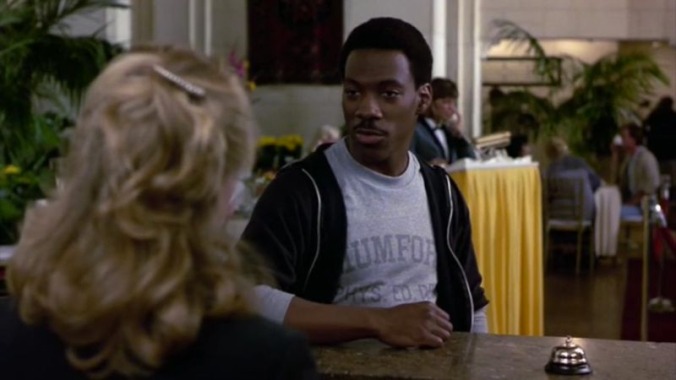But it’s also been seen in movies like Beverly Hills Cop, when Eddie Murphy’s streetwise Detroit detective wanders into what was then the Biltmore’s lobby—but what’s now a place to sip your afternoon tea—then fast-talks his way around the receptionist. Or in Bachelor Party, where Tom Hanks’ rowdy crew sneaks a live donkey onto the elevator, in reckless disregard of the luxury hotel’s stuffy, no-donkeys policy. Or Ghostbusters, where (in addition to its brief scene as the stairs to the roof of Spook Central) the Biltmore doubles as the fictional Sedgewick Hotel, site of the team’s capturing of its first ghost, and its joyous dismantling of what is today the Biltmore’s reception area. It’s where Pretty In Pink’s Andie and Duckie brave the stuck-up preppies of their senior prom. It’s where Fight Club’s Tyler Durden adds a little something to the cream of mushroom soup for the cream of the crop. The Biltmore is the place where the outcasts come to battle the elite on their home turf.
Offscreen, the Biltmore has also played host to its fair share of underdogs and uncouth youngsters, including serving as the campaign headquarters for John F. Kennedy at the 1960 Democratic National Convention, then hosting The Beatles and their raucous teenybopper fans four years later. In the years since, even more (fake) presidents have strolled its grand hallway in movies like Dave and Independence Day, while musicians like Janet Jackson and Britney Spears have danced down it in their videos. (Rod Stewart, by the way, mostly just sat in the bar.)
Its vast rooms are endlessly mutable, capable of playing the smoky nightclub where Michelle Pfeiffer slinks around in The Fabulous Baker Boys, as well as the boxing ring where Rocky Balboa trains to fight Clubber Lang. The classical architecture—filled with priceless chandeliers and murals spanning centuries of baroque and Beaux Arts styles—can evoke practically any time period, standing in for the 1930s in Chinatown, or the 1960s of Bugsy and Mad Men. And its grandiose size makes it an ideal match for larger-than-life blockbusters like Spider-Man, National Treasure, True Lies, and Ocean’s Eleven, as well as other pretenders to high society like Daredevil.
Of course, all those imaginary worlds sharing the same space can make visiting them a little overwhelming. As we walked around with our guest, film locations expert Harry Medved, while he rattled off the hundred different things the Biltmore had been, it began to feel less like we were inside a historic hotel than a soundstage, an artificial set that someone could strike and move at any moment. But then, that’s actually the magic of the Biltmore: It may look posh and impenetrable, but it’s just waiting to be filled with characters to come shake things up.

